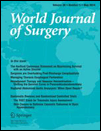Gastrocele Complicates the Course of Non-operated Severe Caustic Injuries: Operative Strategies
Abstract
Background
For selected cases of severe caustic injuries, evidence favors conservative management, consisting of radiographic and clinical observation without emergency surgery. However, this approach can lead to the development of gastric distension caused by combined esophageal and antral strictures, called gastrocele. This study assessed the safety of a two-stage surgical treatment for gastrocele.
Methods
Patients treated in our department between 2004 and 2010 for caustic injury who did not receive emergency surgery and subsequently developed gastrocele were retrospectively analysed. Demographic information, symptoms, and ingestion history were documented. Surgical management included partial gastrectomy and postponed esophageal stricture treatment. Outcome measures included postoperative morbidity and mortality.
Results
Eight nonoperated patients with severe caustic injury from suicidal ingestions of caustic substances were found to have developed gastrocoele. They presented with mostly endoscopic stage IIIb esophageal and gastric injuries. All patients had clinical symptoms of vomiting and abdominal tenderness at day 8 after caustic ingestion. Antrectomy and esophageal stricture treatment were performed at an average of 2 and 8 months, respectively, after caustic ingestion. There were no postoperative deaths, and the long-term survival rate was 83 %.
Conclusions
Gastrocele should be suspected in patients with stage III gastric and esophageal injuries who have been treated by conservative management and are still vomiting more than 1 week postingestion. A two-staged surgical strategy of antrectomy followed by a postponed esophageal stricture treatment was found to be safe and effective for these patients.




